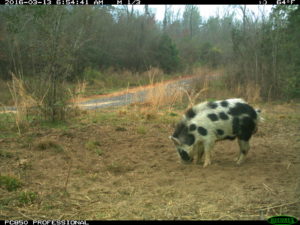UGA researcher provides a targeted approach to address the destructive wild pig population

Wild pigs number between 5 and 6 million in the United States and they cause more than $1.5 billion in damage to property, agriculture, natural resources and cultural artifacts, according to the National Wildlife Research Center of the U.S. Department of Agriculture. But a group of scientists led by a researcher from the University of Georgia has a plan for gaining control of this invasive species.
James Beasley, who heads a research subcommittee of the National Wild Pig Task Force, presented the subcommittee’s recommendations in a study published in the Journal of Wildlife Management.
Although there is existing research on wild pigs—descendants of the domestic pig and the wild boar—the growth of the population has outpaced the research, according to Beasley.
“We lack the empirical data in many areas to direct and evaluate management of the species,” said Beasley, assistant professor at the Savannah River Ecology Laboratory and the Warnell School of Forestry and Natural Resources.
Focusing wild pig research on a few targeted areas under these priorities will facilitate progress toward the national goal, he said.
Kurt C. Vercauteren, project leader at USDA’s NWRC and a member of the subcommittee, agrees.
“Research addressing the priorities laid out in this manuscript will provide the knowledge needed to reduce the populations and negative impacts of invasive wild pigs,” he said.
The subcommittee’s recommendations included exploring factors influencing reproductive rates, determining how groups of wild pigs—known as sounders—form and interact, and determining why the sizes of these groups vary in different parts of the country.
Beyond the structural damage that occurs to property, very little is known about the damage done to natural ecosystems. Beasley said the research needs to determine or quantify the cost to native species that may be in competition with wild pigs for access to habitat and food resources.
Developing species-specific pharmaceuticals and improved bait and trap mechanisms that do no harm to other species is also key to seeing improved management results, according to the subcommittee.
The group also said that illegal transportation of wild pigs by humans to areas where they did not previously exist is a huge factor and influence in the wild pig’s dominance of the landscape.
“A major motivation underlying the relocation issue is hunter’s demand for wild pigs as game,” according to Beasley. “However, an unintentional consequence of the movement of pigs is the damage they inflict on crops and other resources, which has a significant impact on farmers’ wallets,” he said.
There is also a lack of knowledge that the species spreads diseases like brucellosis, E.coli. and other diseases that affect humans, livestock and native wildlife, like the Florida panther.
A major key to turning this around and improving management of the species is educating all stakeholders and measuring the effectiveness of outreach and education.
“Ultimately, the goal is to reduce damages caused by this destructive invasive species,” Beasley said. “And this template is a mechanism to get us there, hopefully within the next 5 to 10 years.”
Additional authors on this study include Stephen S. Ditchkoff and Mark D. Smith, School of Forestry and Wildlife Sciences at Auburn University, Auburn, Alabama, 36849; John J. Mayer, Savannah River National Laboratory, Savannah River Nuclear Solutions, LLC, Savannah River Site, Aiken, South Carolina, 29808.
###
Writer: Vicky L. Sutton-Jackson, 803-725-2752, vsuttonj@srel.uga.edu
Contacts: James C. Beasley, 803-725-5113, beasley@srel.uga.edu
